Anti-aircraft gun-missile complex short-range "Pantsir-С1" 96K6
The first developments on the creation of an anti-aircraft complex are being carried out according to the order of the Soviet air defense in accordance with the OCR “Roman” since the middle of 1990. The gun-rocket anti-aircraft complex was proposed as a short-range system for covering troop groups and C-300 / C-300В complexes. A little later, it offers the SV, Navy, Airborne. When designing a short-range system, materials from the Tunguska-M project 2K22М were used.
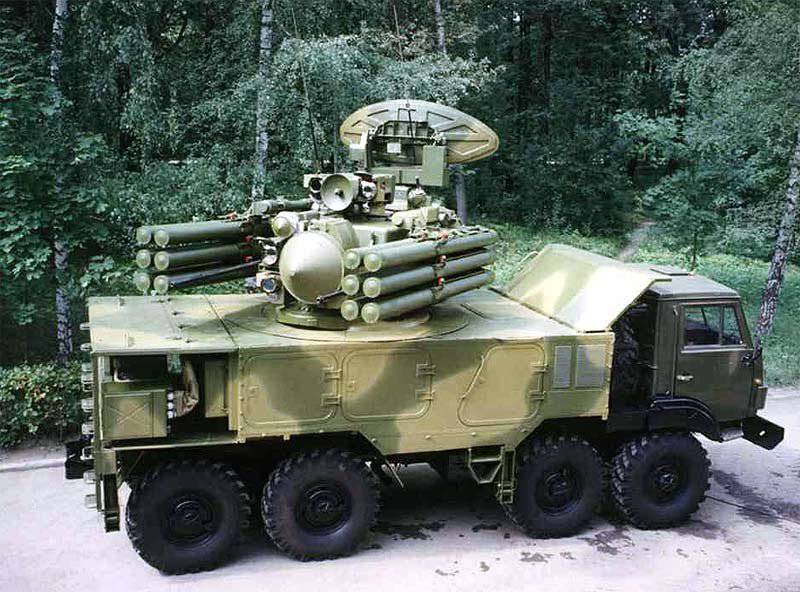
The first prototype of the new complex called “Roman” (Pantsir-С1) was ready for 1994 year. The following year, first shown on MAKS-1995. Due to poor financing, the complex was not acquired by the customer. More or less, funding for the project began in 2000 — funding was provided by the UAE. By 2005, the main customer of the Pantsir-C1 anti-aircraft gun missile system is becoming the Russian Air Force. At present, the need for such a complex is estimated at 100 units. The main tests of the complex took place in 2006-07. The serial production of the Pantsir-С1 complex begins with 2007. It is carried out at the Tula enterprise “Shcheglovsky Val” With the 2008 of the year, the missile defense system “Pantsir-S1” is in service with the Armed Forces of the Russian Federation. In the same year, the arrival of the first short-range complexes in the Russian Air Force was expected.
The first ZPRK DB "Pantsir-S 1" entered service in the number of 10 units in the Russian Air Force in the spring of 2010. According to the available information, up to 2015, more 10 complexes will be put on combat duty. Until 2020, it is planned to provide the Armed Forces of the Russian Federation with hundreds of missile defense missiles of the Pantsir-С1 database.
As part of the work on the Pantsir-C1 project, according to the ESZKV development program, the following development work is underway to create interspecific complexes:
- Redoubt;
- Pantsir-SM;
- anti-aircraft gun and missile system;
- Armor-С1;
- Gladiator.
Prototypes, models and built instances:
the first prototype is the Roman complex consisting of:
- anti-aircraft artillery systems 2X4 9М311;
- artillery armament gun 2X30mm 2А72;
- used chassis - Ural-5323-20;
- diesel engine with turbocharging YMZ-238B 300 hp;
- wheel formula - 8X8 with 2-me front driven axles;
- payload up to 16 tons.
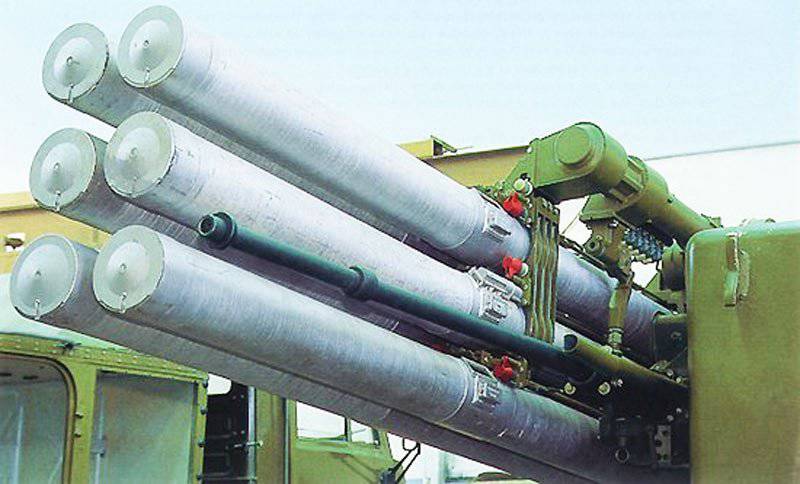
ZPRK DB "Pantsir-С1" - the basic version (prototype) consisting of:
- anti-aircraft artillery systems 2X6 57Е6Е;
- artillery 2 cannon for 2X30mm 2А38М;
- used chassis - MZKT-7930;
- wheel formula - 8X8 with 2-me front driven axles;

ZPRK DB "Pantsir-С1" - the basic version of the sample 2006-07 g, consisting of:
- anti-aircraft artillery systems 2X6 57Е6Е;
- artillery 2 cannon for 2X30mm 2А38М;
- used chassis - KAMAZ-6560;
- wheel formula - 8X8;
- bulletproof cockpit armor;
- HP 400 diesel engine;
- speed up to 90 km / h;
- range to 500 kilometers.
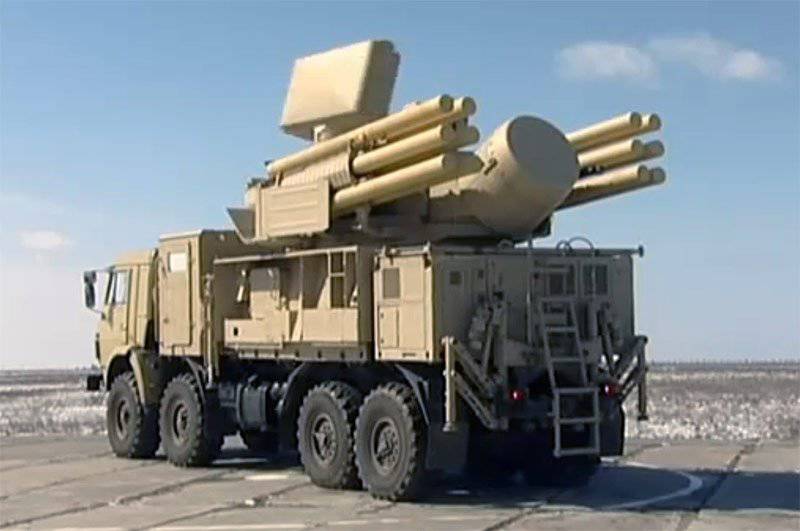
ZRPK 96K6-1 or BM 72В6Е, consisting of:
- anti-aircraft artillery systems 2X6 57Е6Е;
- artillery 2 cannon for 2X30mm 2А38М;
- used chassis - type "Voshchina-1";
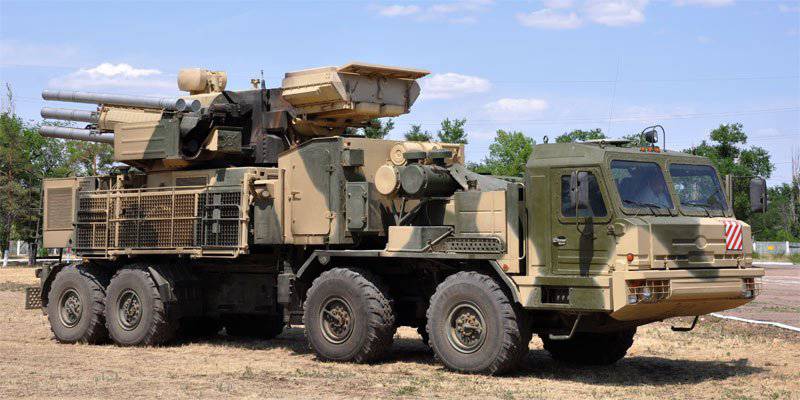
ZPRK DB "Pantsir-S1E" - export version for the United Arab Emirates in the composition:
- used chassis - MAN-SX45
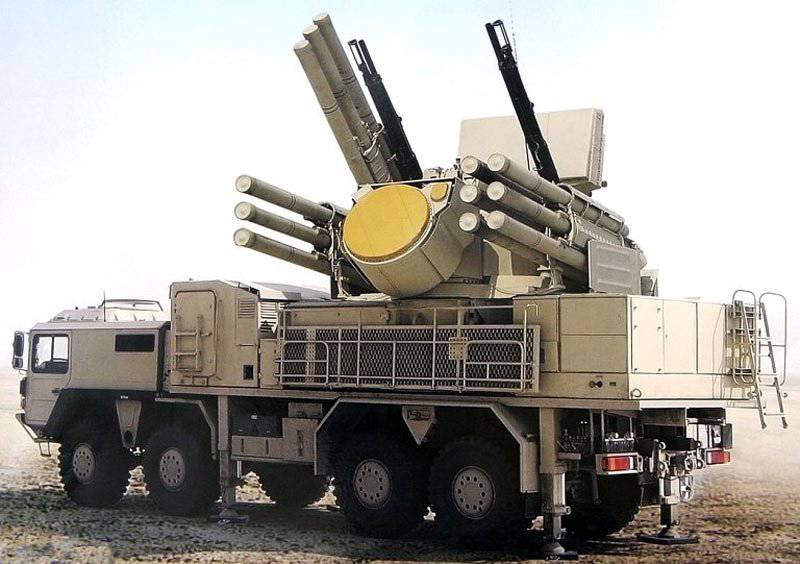
Project version of the complex "Pantsir-С1" MAKS-2009 consisting of:
- used chassis - MZKT-7930
- wheel formula - 8X8.
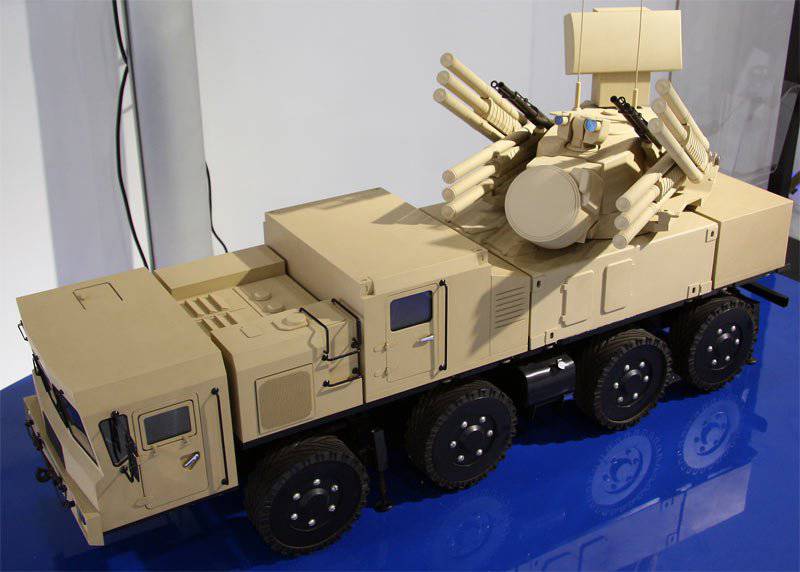
Serial ZRPK database "Pantsir-С1" consisting of:
- anti-aircraft artillery systems 2X6 57Е6Е;
- artillery 2 cannon for 2X30mm 2А38М;
- used chassis - KAMAZ-6560;
- S-band radar module;
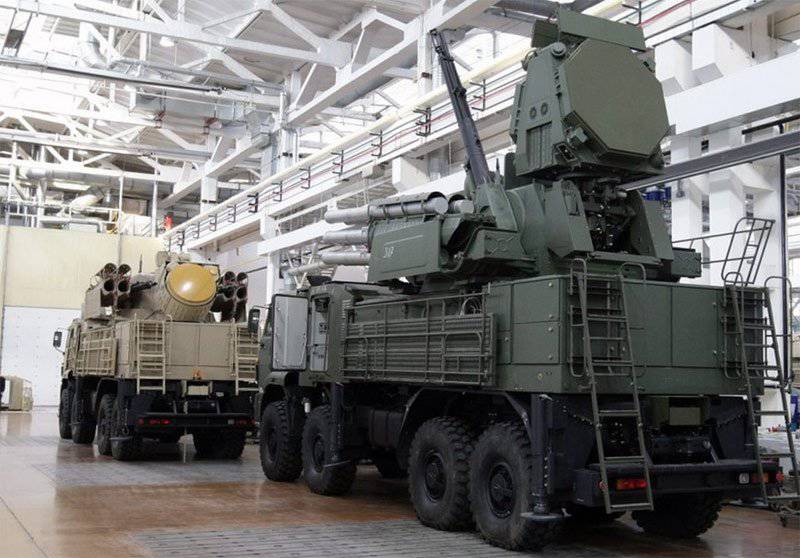
Export version of ZPRK DB consisting of
- anti-aircraft artillery systems 2X6 57Е6Е;
- artillery 2 cannon for 2X30mm 2А38М;
- used chassis - GM-352М1Е;
- wheel formula - tracked;
- bulletproof booking;
- speed up to 70 km / h;
- range to 600 kilometers;
- optoelectronic station.
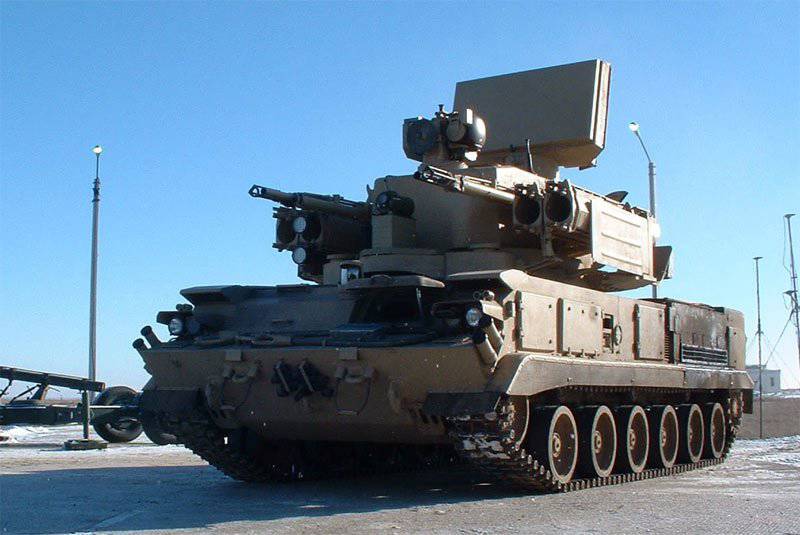
Tracked version ZPRK BD "Armor –С1" consisting of:
- anti-aircraft artillery systems 2X6 57Е6Е;
- artillery 2 cannon for 2X30mm 2А38М;
- used chassis - GM-352М1Е;
- wheel formula - tracked;
- tracking radar (avionics).

The device complex 96K6
The complex is built on a modular design that can be installed on any chassis. The design of the complex consists of the following modules:
- module with weapons;
- tower installation;
- control module;
- module BOT
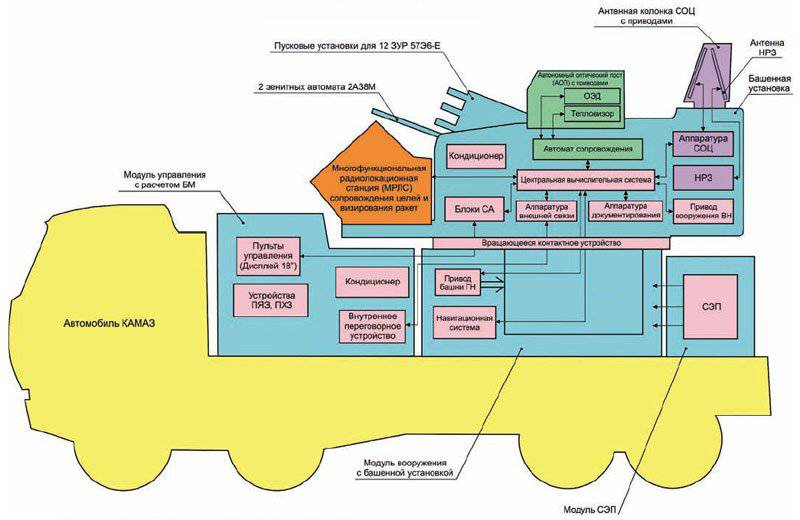
A module with weapons carries rocket and artillery weapons:
- 12-guided bicalyber anti-aircraft 2-x 57-6E stepped missiles with a starting engine (launch stage), detachable at the beginning of the flight trajectory. Marching stage - warhead, contact and non-contact fuses, onboard equipment complex. Aerodynamic scheme missiles "duck". At launch, a rocket reaches a speed of 1300 m / s for a few seconds. The length of the 320 rocket centimeters, weight 74.5 kilogram, weight 20 warhead kilogram. The 57EX6E SAMs are designed to hit air targets at an altitude of 5-15 000 meters and a distance of 1-20 kilometers. Chance to hit - 0.7-0.9. The response time of the complex is up to 6 seconds. Missiles provided with radio command guidance;

- two twin automatic guns 2А38М caliber 30mm. The type of ammunition used - armor-piercing incendiary projectiles. The guns are designed to destroy airborne objects at altitudes up to 3-km and distance to 4-km. Shells have an initial speed 960 m / s. The 5 cannons fire rate is thousands of high / min., In the early 2А72 version, the firing rate did not exceed 700 high / min. 842 gram ammunition weight, 389 gram weight. Guidance is carried out using radar data (PAR) or by means of an infrared sight.
The tower installation bears the armament module, radar, optoelectronic detection systems, the S-band SOC, the navigation system, and the weapons and equipment drives.
The control module has control equipment, communication facilities and additional equipment. It is the calculation of the combat vehicle - the commander of the machine, the gunner, the operator.
A feature of the complex is the possibility of combining a system of multi-channel capture and tracking of air objects with artillery weapons. "Pantsir-С1" can be used for firing at ground objects. To increase the noise immunity of the SU ZUR can change the frequency of radiation with a maximum speed up to 3.5 thousands of IMC / s under the laws of pseudo-randomness in a wide range. The complex has the ability to perform combat missions, both offline and as part of a unit (air defense). The first prototype could fire only from a place. The following, upgraded versions (SU), provided the possibility of firing on the march.
Detection and tracking systems:
- radar station with a phased cm-band antenna array 1PC1-1Е;
- radar stations with phased antenna arrays of cm and mm 1PC2 and 1PC2-1E Helmet ranges for tracking airborne targets and missile guidance;
- an autonomous optical post consisting of an optoelectronic complex with a thermal imaging long-wave receiver (infrared direction finder) for additional target search according to radar detection with the determination of the angular coordinates of objects and missiles. It is applied at any time of the day;
- a central computing complex designed for digital processing of incoming signals and auto-tracking of targets. At the same time it is possible to track two targets for radar and optical-electronic channels. Providing firing at the target with two missiles. The maximum speed of capture of air objects to 10 units per minute;
- Radar module SOTS S-band, designed to detect, recognize and auto-track targets in the presence of active or passive interference in the detection range and tracking more than 40 kilometers. At the same time, target tracking up to 40 units is possible.
Possibilities of combat use of the complex:
- single (autonomous) performance of combat missions - detection, tracking, defeat of targets with their own means, without attracting additional funds;
- performance of combat missions as part of a battery - one of the complexes works as a BM and a gearbox simultaneously. The rest of the complexes (3-5 units) are connected to it in order to get target indications and production for firing targets;
- performance of combat missions as part of a battery with a standard CP - the complexes are connected to the CP, which is in charge of the control center for each complex. ZPRK DB "Pantsir-С1" fire at targets;
- performance of combat missions as part of a battery with a full-time gearbox and early warning radar - the radar issues information to the gearbox, which processes it and issues the target control center to the complexes to carry out fire on targets;
- performance of combat missions in the auto mode by external target designation as a separate combat unit or in a subunit consisting of several BM.
Battery Composition:
- 3-6 BM ZPRK DB "Pantsir-S 1";
- control point (battery);
- 1-3 TZM from the calculation of the machine on the 2 BM. TZM performed on the chassis KAMAZ-6560. It is provided with manipulators (crane type). Carry stock - 24 transport container with missiles and artillery kits;
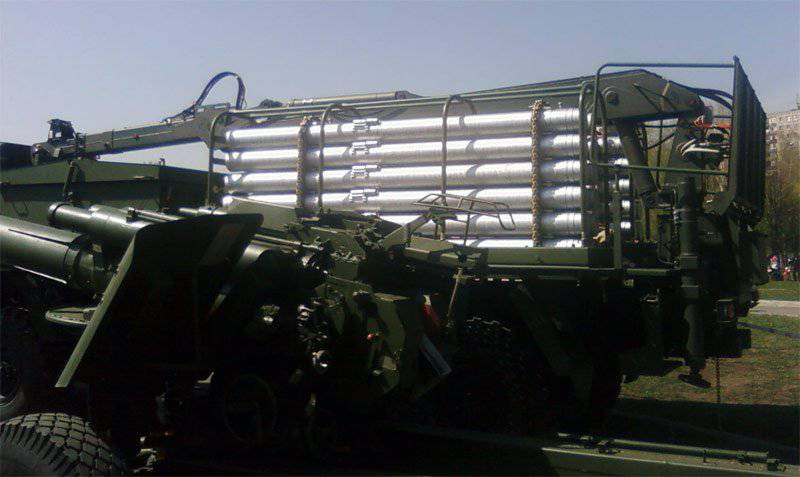
- training equipment;
- maintenance and repair tools which include MRTO (technical support machine);
- tuning machine (alignment) of the systems and complexes Pantyr-С1.
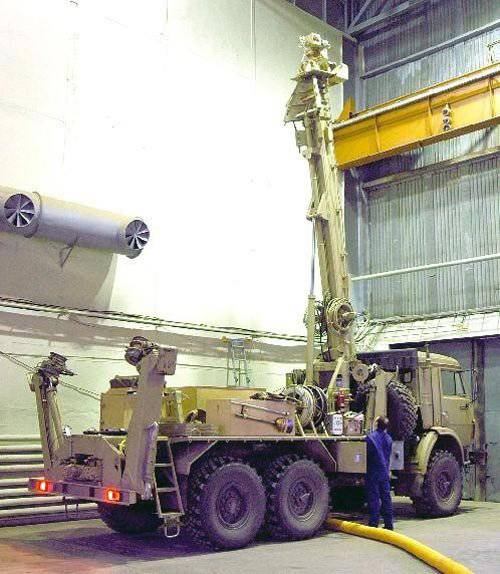
Modifications of the complex:
- ZPRK "Roman" - the first prototype, made on the chassis Ural-5323-20. Created in 1994;
- ZPRK 96K6 - serial version, made on the chassis of KAMAZ-6560. Created in 2005 year.
- ZNRK 30YU6 “Armor – С1-О” - remodeling version 96K6 “Armor-С1”. No tracking radar, optical control system installed weapons.
- “Pantsir-С1” of stationary version - a draft version of ZPRK without a chassis;
- “Pantsir-S1E” ZTRK - ZNRK 96K6 “Pantsir-S1” of export purpose, made on the MAN chassis. Used equipment of foreign manufacture. SAM - 9М311;
- “Pantsir-2E” ZTRK is a special model developed in 2006 year. Tracking radar with improved parameters;
-ZPRK 96K6-1 "Armor-С1" (BM 72В6Е) - a modification of the complex, made on the chassis "BAZ-6909-019";
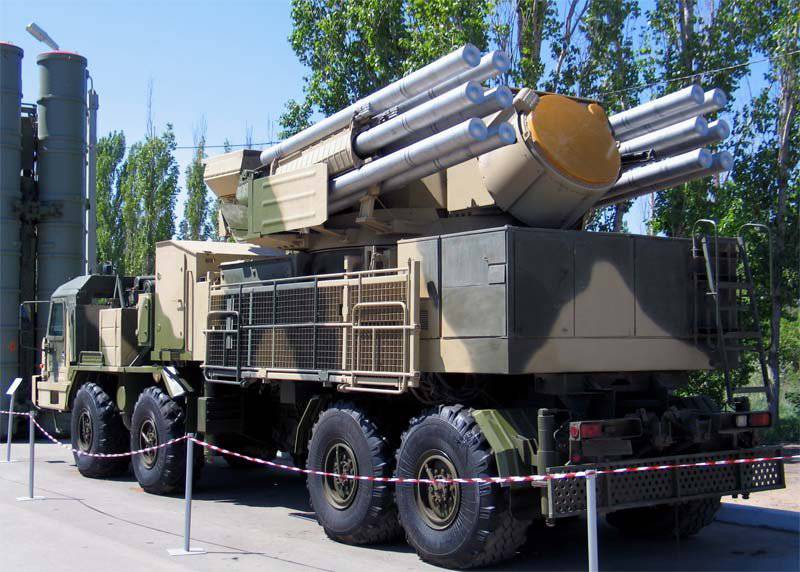
- The Pantsir-C1 radar station with the S-band radar module. The prototype of the complex according to the TZ MO RF TsKBA. Successfully passed the test in the middle of the year 2011.
- ZPRK "Pantsir-M" (Palitsa) - ship modification of the complex. Prototype development in progress. It is expected to install complexes on the TKR 11435 project, approximately up to 6-TPRK. Installation is planned for the modernization of TAKR.
- The Pantsir-ME ZRSR is an export modification of the Pantsir-M ZPRK.
Reporting dates:
- 2008 year - adoption for service in the Armed Forces;
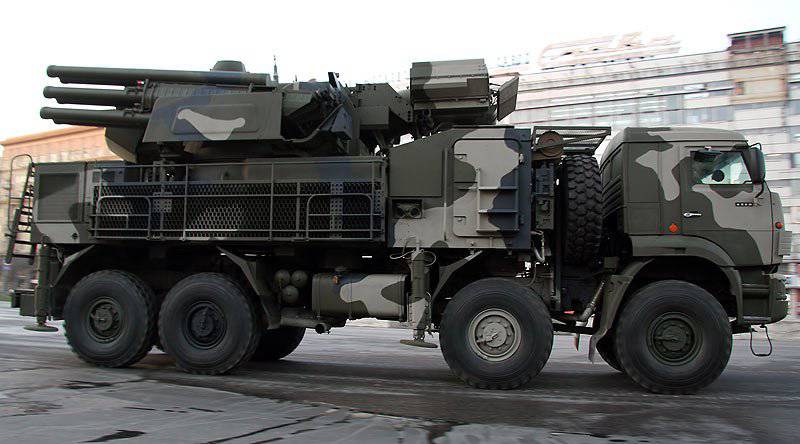
- 2010 year - the Air Force of the Russian Federation receives the 10-m of the missile defense system "Pantsir-C1";
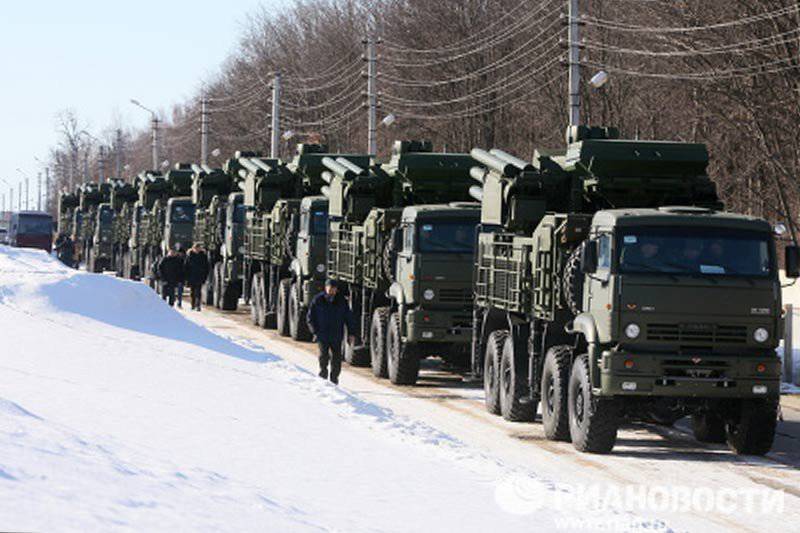
- 2010 year - the manufacturer received orders with a total value of 2.5 billion dollars, which corresponds to a minimum of 175 units Pantyr-С1;
- August 2012 of the year - scheduled to be fired at the Pantsir-С1 complexes at the Ashuluk training ground.
Export shipments:
- Algeria - it is planned to deliver 38 complexes to 2016;
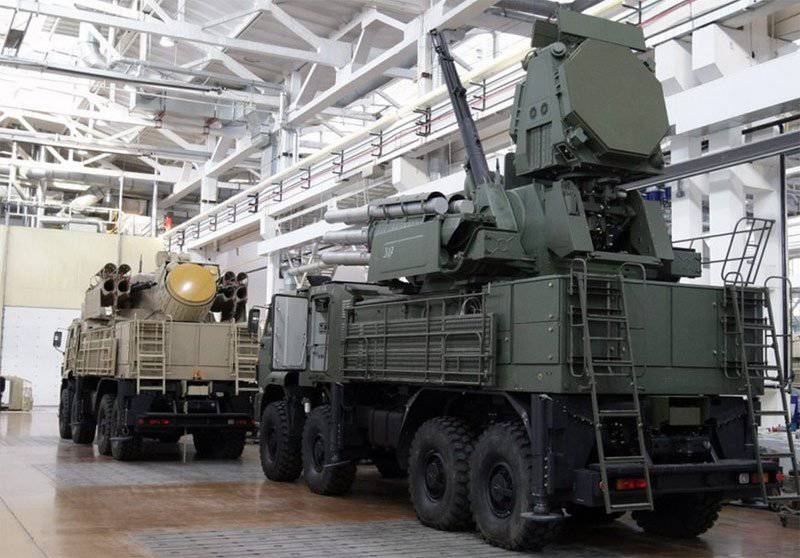
- Iran - probably is armed with 10 complexes "Pantsir-C1E";
- Morocco - an order was made for the 50 of the Pantsir-C1E complexes;
- UAE - from 50 complexes at the time delivered about 30 units. Expected closing order this year;
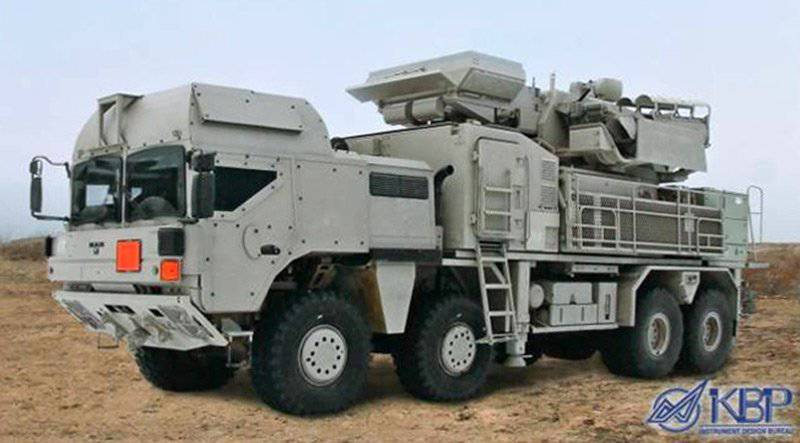
- Oman - probably is armed with about 12-t complexes "Pantsir-S1E."
- Syria - is in service with about 36 units PTR-C1E. 22.06.2012 of the year from the Syrian anti-missile defense missile "Pantsir-C1E" shot down a Turkish intelligence officer "RF-4E";
The main characteristics of the ZRPK 96K6:
- estimated cost (export) - 13-14.7 million dollars;
- combat weight - 20 000 kilogram (depending on the chassis);
- combat crew - three people;
- translation into a firing position - less than 5 minutes;
- reaction time of the complex - no more than 6 seconds
- detection range over 36 kilometers;
- tracking distance more than 30 kilometers;
Cannon-rocket armament:
two twin anti-aircraft machine 2А38М
- ammunition - 1400 shots;
- effective range of destruction to 4-x kilometers;
- fire speed (total) - 5 thousand high / min;
- ammunition - armor-piercing incendiary;
12-guided anti-aircraft missiles 57-6-E
- performance - supersonic 2-x speed solid;
- missile guidance - radio command;
- rocket length - 3.2 meter;
- flight speed max / average - 1300 / 700 m / s;
- speed of the target to be hit up to 1000 m / s;
- effective range of 1.2-20 kilometers;
- target height to 15 kilometers;
- caliber –90 / 76 bicalyber;
- weight - 74.5 kilogram;
- BB weight - 5.5 kilogram.
Additional Information:
In 2012, at the open scientific and technical conference of the Ministry of Defense of the Russian Federation and RARAN, the assessment of the Pantsir-С1 system was announced.
The main advantage of the DPRB database "Armor-C 1" - automatic operation.
The main disadvantages according to field testing:
- low possibility of firing air objects flying and maneuvering with the course parameter 2-3 km;
- the possibility of hitting targets flying at speeds of 400 m / s and more (TTX - 1000м / s) was not confirmed;
- at maximum range, fire is conducted on air objects flying at a speed of less than 80 m / s;
- used bikalibernaya missile has guidance errors for actively maneuvering targets;
- not received confirmation of the possibility of destruction of tactical missiles or their units;
- small-scale targeting of missiles;
- ineffective coordination of elements of missiles;
- a noticeable influence of weather conditions on the detection range of air objects;
- overall characteristics and the complete absence of armor will not allow the use of the complex in the forward order of the covered units;
- dimensions of the BM ZPRK BD "Pantsir-С1" do not allow to move it by rail;
- the time required to transfer the complex to the combat position exceeds the stated time by 1.5 times.
- big time of shipment of ammunition with TZM (up to 30 minutes).
- there is no accurate data on the safety of fire of missiles;
- the existence of the possibility of overturning when firing from artillery weapons;
- dependence on import element base;
- tracked complex costs almost 50 per cent more expensive than the wheel variant
Summarized:
- in terms of cost-effectiveness, the Pantsir-С1 is COST;
- Active X-ray means lead to unmasking of the complex;
- it may take more than three years to transfer the REA complex to the domestic element base;
- for the expediency of using "Pantsir-С1" will require a lot of work on the coordination of various programs.
Information sources:
http://bmpd.livejournal.com/197121.html
http://pvo.guns.ru/panzir/index.htm
http://militaryrussia.ru/blog/topic-558.html
http://army.lv/ru/pantsir-s1/703/461
http://www.youtube.com/watch?v=lu50snDorVY
Information